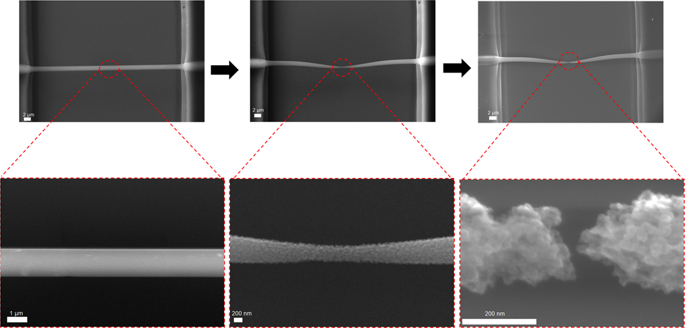Microsystems & Nanoengineering ( IF 7.3 ) Pub Date : 2020-01-27 , DOI: 10.1038/s41378-019-0120-z Arnoldo Salazar 1 , Samira Hosseini 1 , Margarita Sanchez-Domínguez 2 , Marc J Madou 1, 3 , Alejandro Montesinos-Castellanos 1 , Sergio O Martinez-Chapa 1

|
Glassy carbon nanofibers (GCNFs) are considered promising candidates for the fabrication of nanosensors for biosensing applications. Importantly, in part due to their great stability, carbon electrodes with sub-10 nm nanogaps represent an attractive platform for probing the electrical characteristics of molecules. The fabrication of sub-10 nm nanogap electrodes in these GCNFs, which is achieved by electrically stimulating the fibers until they break, was previously found to require fibers shorter than 2 µm; however, this process is generally hampered by the limitations inherent to photolithographic methods. In this work, to obtain nanogaps on the order of 10 nm without the need for sub-2 µm GCNFs, we employed a fabrication strategy in which the fibers were gradually thinned down by continuously monitoring the changes in the electrical resistance of the fiber and adjusting the applied voltage accordingly. To further reduce the nanogap size, we studied the mechanism behind the thinning and eventual breakdown of the suspended GCNFs by controlling the environmental conditions and pressure during the experiment. Following this approach, which includes performing the experiments in a high-vacuum chamber after a series of carbon dioxide (CO2) purging cycles, nanogaps on the order of 10 nm were produced in suspended GCNFs 52 µm in length, much longer than the ~2 µm GCNFs needed to produce such small gaps without the procedure employed in this work. Furthermore, the electrodes showed no apparent change in their shape or nanogap width after being stored at room temperature for approximately 6 months.
中文翻译:

悬浮玻璃碳纳米纤维上的亚 10 nm 纳米间隙制造
玻璃碳纳米纤维 (GCNF) 被认为是制造用于生物传感应用的纳米传感器的有希望的候选材料。重要的是,部分由于其出色的稳定性,具有亚 10 nm 纳米间隙的碳电极代表了用于探测分子电学特性的有吸引力的平台。在这些 GCNF 中制造亚 10 nm 纳米间隙电极,这是通过电刺激纤维直到它们断裂来实现的,以前发现需要短于 2 µm 的纤维;然而,这个过程通常受到光刻方法固有的限制的阻碍。在这项工作中,为了在不需要亚 2 µm GCNF 的情况下获得 10 nm 数量级的纳米间隙,我们采用了一种制造策略,通过连续监测纤维电阻的变化并相应地调整施加的电压,纤维逐渐变细。为了进一步减小纳米间隙尺寸,我们通过控制实验过程中的环境条件和压力来研究悬浮的 GCNF 变薄和最终分解背后的机制。遵循这种方法,其中包括在一系列二氧化碳 (CO2 ) 净化循环,在 52 µm 长度的悬浮 GCNF 中产生了 10 nm 数量级的纳米间隙,比在没有这项工作中使用的程序的情况下产生如此小的间隙所需的 ~2 µm GCNF 长得多。此外,电极在室温下储存约 6 个月后,其形状或纳米间隙宽度没有明显变化。











































 京公网安备 11010802027423号
京公网安备 11010802027423号